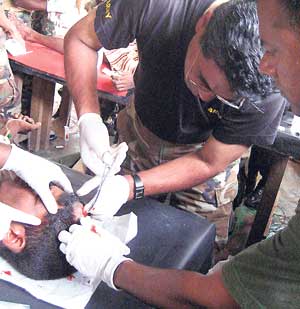‘Faithful in Distress’ is their motto and with the increasing intensity of battle in recent months and resulting increase in the number of casualties on both sides, the personnel of the Sri Lanka Army Medical Corps have been working with great commitment to attend to this vital part of the war effort.
“On November 16 last year at Akkarayankulam, just before entering Kilinochchi town, we had 215 casualties coming in throughout the day,” recalled Major Sanjeeva Dodangoda, a medical officer who was serving at an Advanced Dressing Station (ADS). “There was heavy fighting that day and as the casualties were brought in, we got assistance from other ADS in the vicinity. Ambulance, staff and doctors came to our aid and we worked from about 7 a.m. till 10.30 p.m. without a break. The patients needing urgent attention were evacuated by air and road to hospitals for treatment,” he said, detailing the intense effort made to treat the wounded.
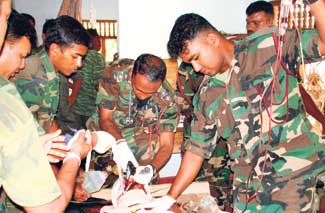 |
|
Brigadier Sanjeeva Moonesinghe, Director of the Army Medical Corps, explained that the Medical Corps comprises three regular units and one volunteer unit. The first to handle casualties in the forward area are the Nursing Assistants who have first aid training. It is they who administer the initial treatment and take the patient to the unit headquarters in the battle area, where a qualified nurse rechecks the patient. The next step is the Advanced Dressing Stations (ADS) at Brigade headquarters, with a medical officer or RMO. Here minor surgeries and emergency life-saving procedures are carried out. The Main Dressing Stations (MDS) at Division headquarters are manned by senior medical officers and from there patients are evacuated to Field Hospitals or Army Base Hospitals.
Brigadier Moonesinghe said they have had a very good response from the Health Ministry and the government hospitals. Government doctors have come to Anuradhapura, Mannar, Vavuniya and Pallaly to assist with the casualties. “When space is needed we transfer patients to some government hospitals. Their doctors and staff have been very cooperative,” he said.
The major battlefronts now being concentrated mainly in the Wanni, the medical needs are met by the SL Army 3 Medical Corps, headquartered at Nelum Kulama camp in Anuradhapura. “All equipment, drugs and manpower to the five Divisions and six Task Forces in the area, numbering over 100 medical units, are supplied from here,” said Major Upul Rajapakse, Officer in Charge of 3 Medical Corps. “We are responsible for the patients until they are received at the hospital.” Major Rajapakse visits the medical units to find out their requirements of drugs and equipment. “We have no problem with drugs,” Major Rajapakse said. “Whatever is needed is airlifted immediately by our Directorate and we have buffer stocks even at MDS. During the recent shortage of Pethedine, we were able to manage using morphine. ” He commended the Air Force for the marvellous job they are doing in the evacuation of patients and flying in urgent drugs.
In the lecture hall at the Nelum Kulama camp, we meet army nurses and nursing assistants serving in the battlefront. Lance Cpl. Manikka, a Nursing Assistant, served in Vishvamadu when this area was captured by the army. “I was moving with the fighting troops, about 200 metres behind the frontline,” Lance Corporal Manikka said. “Casualty parties from the Infantry bring the patients to us and the first treatment is given by us. Each company sets up a small station for this. We examine the patient, try to arrest bleeding, introduce an intravenous access, give saline when necessary, put dressings, splints on fractured limbs, and give pain killers.” In the casualty parties, Infantry soldiers are trained in combat life saving. After initial treatment the patients are taken to an ADS at Brigade headquarters, by tractor or any available transport if there is no ambulance access to that point.
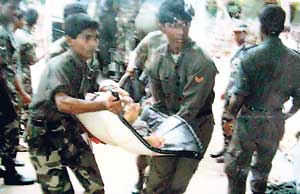 |
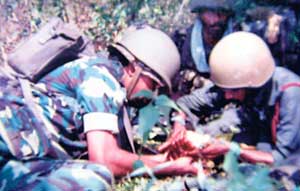 |
Staff Sergeant Dissanayake, who counts 18 years in the army and served 1 ½ years as a Nurse in the ADS of 57 and 58 Divisions is a veteran of many battles. The ADS is moved as the troops move forward, housed in a temporary building or tent or in any available building, he said. Two nurses and three nursing assistants serve in the ADS along with an ambulance and driver.
There is a representative from each battalion too. “An ADS has equipment and facilities to treat 400 casualties,” added Major Dodangoda. “When manpower is short we get help. When an operation is planned we work out from where extra medical officers could be drawn.”
Advanced Dressing Stations are located about 3 – 4 km away from the frontlines as decided by the Field Commanders. A relatively safe place is needed, although there is the threat of artillery fire.
Staff Sergeant M. Senadheera recalled how the LTTE had broken into the defence line on February 2nd and 3rd, and there were many casualties. “We combined two or three ADS and the Main Dressing Station (MDS) at Division headquarters, and worked together to treat the patients. Three doctors from the MDS were airlifted to the ADS. We were able to save a lot of lives, resuscitate and evacuate the patients straight to hospital.”
From December to January, troops had gone through jungle to Vishvamadu where there was no road access. When casualties were received in the evening, they were airlifted by chopper to the ADS. The MDS from Task Force 3 also came into the jungle. A small temporary hut was erected and doctors worked through the night, setting up a medical ward and a surgical ward. ‘It was like a war film,” Senadheera commented.
“The ambulance drivers also do a round the clock job,” he added. During the monsoon when they could not get a chopper, four-wheel drive ambulances and cabs were used to take casualties to Vavuniya.
When casualties need evacuation, a nurse and ambulance are sent as far as possible to bring the patient to the ADS, said Major Prasanna Pushpakumara, second-in-command at the Army Victory Hospital. “At the ADS the patient is given any additional treatment necessary. Blood is given if there is a doctor. Initial categorization of the patients is also done. P1 patients are those who need immediate treatment and are evacuated immediately. P2 patients need treatment but not urgently. P3 patients are also sent to MDS for re-evaluation. “If there is a head injury the patient is transferred immediately to MDS with nurse. The priority is to save life.”
Major Dodangoda and Major Pushpakumara maintain a two-week roster at the MDS, on a rotational basis. The MDS has almost all the facilities of a Field Hospital. There is always a Medical Officer, together with five nurses, PHI, storeman, lab technician, ambulance and driver and a clerk. All MDS staff are trained as nursing assistants, even the ambulance driver. A blood store and portable ventilator are available for life-saving surgery undertaken at MDS. All army doctors have undergone training in anaesthesia, Major Rajapakse said.
As the patient is re-evaluated at MDS, decisions are taken on emergency surgery, life saving procedures, mode of evacuation or discharge back to the field. A ward is also maintained for medical casualties. If further investigation is needed they are referred to Army Hospital or Field Hospital. “The army doctor is the sole physician, surgeon and anaesthetist,” Major Rajapakse said. “We have to do all we can to save lives. Sometimes we get over 100 casualties per day. The nurses are those who have four years training. With the experience they get here they can work anywhere.”
Major Dodangoda said they also treat civilians fleeing from LTTE occupied areas, at the MDS. Even captured LTTE cadres are sometimes brought under Army escort. After the blast at Vishvamadu recently, injured internally displaced persons (IDPs) were brought in and treated. Two nursing assistants are assigned for duty at the IDP receiving points manned by the Army. Minor ailments are treated there, while those needing urgent attention are taken to the MDS. After initial treatment they are taken to the General Hospital at Vavuniya or Anuradhapura.
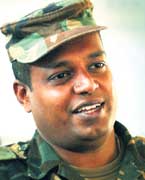 |
| Major Upul Rajapakse |
After life saving treatment, P1 casualties from the Wanni frontlines are evacuated by air to Anuradhapura, where they are admitted to the Army Victory Hospital or the Anuradhapura Teaching Hospital. When The Sunday Times visited this hospital, the staff was preparing to receive casualties from the front.
The patients are admitted to the Army Ward as well as to other wards. The P1 patients are divided between the two hospitals, according to the injuries. “The Director, doctors, nurses and minor staff of the Teaching Hospital are doing a great service in this Eelam War 4,”Major Rajapakse said.
Jayantha Pathirana, 30, whom we met in the army ward had been injured while fighting in the front line at Mullaitivu. “When I fell, my colleagues took me to the nursing station. I was then transported by tractor to the ADS and by chopper to Anuradhapura. My leg was amputated last night as soon as I was brought in. Now the pain is less. We are being well looked after by our doctors and nurses,” he said.
Speaking to the injured soldiers, we found that despite their injuries, their morale is high. Cpl. Ruwan Kumara had been injured by a RPG at the front line at Puthukudiyiruppu and brought to Anuradhapura by chopper the previous night. Categorised as P2, he was awaiting surgery. “The war is going successfully. We have a little more left to be won and we must finish it,” he asserted.
At the Victory Hospital, the wards and the OPD are filled to capacity. Major H.M.W. Herath, Commanding Officer of the hospital said that apart from the war casualties, they also treat the soldiers in the area and their families, attending to around 400 – 600 OPD patients a day. Patients are provided with all meals. Even the meals for army patients at the Government Hospital are supplied by the Victory Hospital. When casualties are brought in from the battlefield, all their basic needs of clothing and toiletries are supplied to them on arrival.
“Despite a shortage of manpower, we somehow manage to support our troops at the front,” Major Rajapakse said. We appreciate the cooperation we get from the government hospitals. It is a collective effort with the hospitals and our Directorate. It is accepted as a national requirement. From labourer and ambulance driver to medical officers, all work together with commitment. We need more doctors and nursing staff to take this work forward even more.” |


